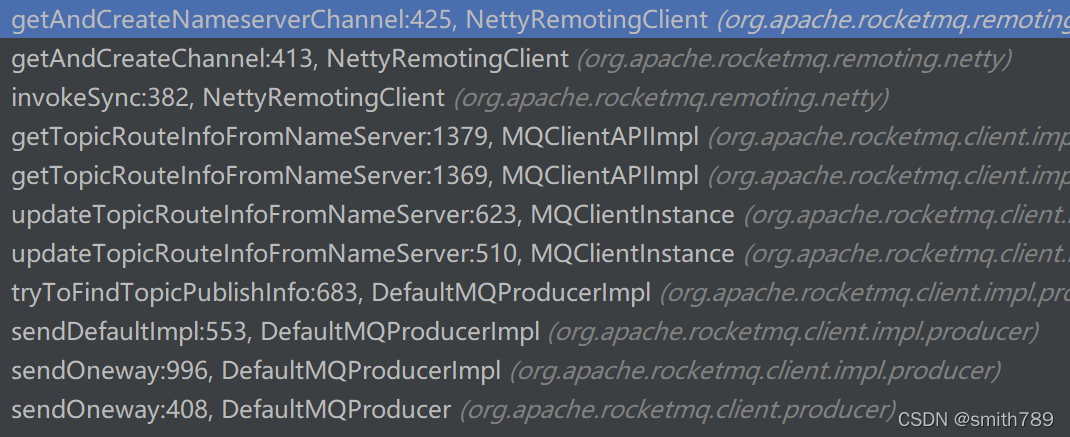前提条件
1、NameServer已启动。各个NameServer无状态,无通信。
2、broker已启动。

3、broker启动时,加载$HOME/store/config/topics.json里的信息,定时注册到3个NameServer里。
{
"dataVersion":{
"counter":3,
"timestamp":1647074381689
},
"topicConfigTable":{
"SCHEDULE_TOPIC_XXXX":{
"order":false,
"perm":6,
"readQueueNums":18,
"topicFilterType":"SINGLE_TAG",
"topicName":"SCHEDULE_TOPIC_XXXX",
"topicSysFlag":0,
"writeQueueNums":18
},
"SELF_TEST_TOPIC":{
"order":false,
"perm":6,
"readQueueNums":1,
"topicFilterType":"SINGLE_TAG",
"topicName":"SELF_TEST_TOPIC",
"topicSysFlag":0,
"writeQueueNums":1
},
"%RETRY%testGroupName":{
"order":false,
"perm":6,
"readQueueNums":1,
"topicFilterType":"SINGLE_TAG",
"topicName":"%RETRY%testGroupName",
"topicSysFlag":0,
"writeQueueNums":1
},
"DefaultCluster":{
"order":false,
"perm":7,
"readQueueNums":16,
"topicFilterType":"SINGLE_TAG",
"topicName":"DefaultCluster",
"topicSysFlag":0,
"writeQueueNums":16
},
"DefaultCluster_REPLY_TOPIC":{
"order":false,
"perm":6,
"readQueueNums":1,
"topicFilterType":"SINGLE_TAG",
"topicName":"DefaultCluster_REPLY_TOPIC",
"topicSysFlag":0,
"writeQueueNums":1
},
"RMQ_SYS_TRANS_HALF_TOPIC":{
"order":false,
"perm":6,
"readQueueNums":1,
"topicFilterType":"SINGLE_TAG",
"topicName":"RMQ_SYS_TRANS_HALF_TOPIC",
"topicSysFlag":0,
"writeQueueNums":1
},
"TBW102":{
"order":false,
"perm":7,
"readQueueNums":8,
"topicFilterType":"SINGLE_TAG",
"topicName":"TBW102",
"topicSysFlag":0,
"writeQueueNums":8
},
"BenchmarkTest":{
"order":false,
"perm":6,
"readQueueNums":1024,
"topicFilterType":"SINGLE_TAG",
"topicName":"BenchmarkTest",
"topicSysFlag":0,
"writeQueueNums":1024
},
"OFFSET_MOVED_EVENT":{
"order":false,
"perm":6,
"readQueueNums":1,
"topicFilterType":"SINGLE_TAG",
"topicName":"OFFSET_MOVED_EVENT",
"topicSysFlag":0,
"writeQueueNums":1
}
}
}
4、由于所有NameServer节点里的路由信息都一致,所以producer选择任一一个NameServer与之通信,获得topic路由信息。
Producer发送消息源码分析
DefaultMQProducer producer = new DefaultMQProducer(Constants.TEST_GROUP_NAME);
producer.setNamesrvAddr(Constants.NAME_SERVER);
producer.start();
Message msg = new Message(Constants.TEST_TOPIC_NAME,
Constants.TEST_TAG, "key" + i,(Constants.HELLO_ROCKETMQ + i).getBytes(RemotingHelper.DEFAULT_CHARSET));
producer.sendOneway(msg);
producer启动主要流程

sendOneWay
start()方法初始化, sendOneWay拼装、发送消息。
调用tryToFindTopicPublishInfo方法,从topicPublishInfoTable中寻找topic路由信息。
Producer启动的时候,先向NameServer发起请求,询问topic路由信息。
如果找不到,调用updateTopicRouteInfoFromNameServer从NameServer获取topic路由信息。
如果找到了,调用updateTopicRouteInfoFromNameServer更新本地的topic路由信息。
private TopicPublishInfo tryToFindTopicPublishInfo(final String topic) {
TopicPublishInfo topicPublishInfo = this.topicPublishInfoTable.get(topic);
if (null == topicPublishInfo || !topicPublishInfo.ok()) {
this.topicPublishInfoTable.putIfAbsent(topic, new TopicPublishInfo());
this.mQClientFactory.updateTopicRouteInfoFromNameServer(topic);
topicPublishInfo = this.topicPublishInfoTable.get(topic);
}
if (topicPublishInfo.isHaveTopicRouterInfo() || topicPublishInfo.ok()) {
return topicPublishInfo;
} else {
this.mQClientFactory.updateTopicRouteInfoFromNameServer(topic, true, this.defaultMQProducer);
topicPublishInfo = this.topicPublishInfoTable.get(topic);
return topicPublishInfo;
}
}
topicPublishInfoTable是什么结构?
private final ConcurrentMap<String/* topic */, TopicPublishInfo> topicPublishInfoTable =
new ConcurrentHashMap<String, TopicPublishInfo>();
不同于broker的topic信息,client启动的时候,默认只有一个TBW102的topic。

updateTopicRouteInfoFromNameServer做了什么?
通过getDefaultTopicRouteInfoFromNameServer从NameServer获取topic信息T1,将T和和本地topicRouteTable中的topic(T2)比较,看是否需要更新。
T1结构一览:

public boolean updateTopicRouteInfoFromNameServer(final String topic, boolean isDefault,
DefaultMQProducer defaultMQProducer) {
try {
if (this.lockNamesrv.tryLock(LOCK_TIMEOUT_MILLIS, TimeUnit.MILLISECONDS)) {
try {
TopicRouteData topicRouteData;
if (isDefault && defaultMQProducer != null) {
topicRouteData = this.mQClientAPIImpl.getDefaultTopicRouteInfoFromNameServer(defaultMQProducer.getCreateTopicKey(),
clientConfig.getMqClientApiTimeout());
if (topicRouteData != null) {
for (QueueData data : topicRouteData.getQueueDatas()) {
int queueNums = Math.min(defaultMQProducer.getDefaultTopicQueueNums(), data.getReadQueueNums());
data.setReadQueueNums(queueNums);
data.setWriteQueueNums(queueNums);
}
}
} else {
topicRouteData = this.mQClientAPIImpl.getTopicRouteInfoFromNameServer(topic, clientConfig.getMqClientApiTimeout());
}
if (topicRouteData != null) {
TopicRouteData old = this.topicRouteTable.get(topic);
boolean changed = topicRouteDataIsChange(old, topicRouteData);
if (!changed) {
changed = this.isNeedUpdateTopicRouteInfo(topic);
} else {
log.info("the topic[{}] route info changed, old[{}] ,new[{}]", topic, old, topicRouteData);
}
if (changed) {
TopicRouteData cloneTopicRouteData = topicRouteData.cloneTopicRouteData();
for (BrokerData bd : topicRouteData.getBrokerDatas()) {
this.brokerAddrTable.put(bd.getBrokerName(), bd.getBrokerAddrs());
}
…………
log.info("topicRouteTable.put. Topic = {}, TopicRouteData[{}]", topic, cloneTopicRouteData);
this.topicRouteTable.put(topic, cloneTopicRouteData);
return true;
}
}
getTopicRouteInfoFromNameServer做了什么?
封装了一个RequestCode.GET_ROUTEINFO_BY_TOPIC的Netty command。
public TopicRouteData getTopicRouteInfoFromNameServer(final String topic, final long timeoutMillis,
boolean allowTopicNotExist) throws MQClientException, InterruptedException, RemotingTimeoutException, RemotingSendRequestException, RemotingConnectException {
GetRouteInfoRequestHeader requestHeader = new GetRouteInfoRequestHeader();
requestHeader.setTopic(topic);
//******************look at me plz********************************************
RemotingCommand request = RemotingCommand.createRequestCommand(RequestCode.GET_ROUTEINFO_BY_TOPIC, requestHeader);
RemotingCommand response = this.remotingClient.invokeSync(null, request, timeoutMillis);
assert response != null;
switch (response.getCode()) {
case ResponseCode.TOPIC_NOT_EXIST: {
if (allowTopicNotExist) {
log.warn("get Topic [{}] RouteInfoFromNameServer is not exist value", topic);
}
break;
}
case ResponseCode.SUCCESS: {
byte[] body = response.getBody();
if (body != null) {
return TopicRouteData.decode(body, TopicRouteData.class);
}
}
default:
break;
}
throw new MQClientException(response.getCode(), response.getRemark());
}
Netty封装通用调用方法
public RemotingCommand invokeSync(String addr, final RemotingCommand request, long timeoutMillis)
throws InterruptedException, RemotingConnectException, RemotingSendRequestException, RemotingTimeoutException {
long beginStartTime = System.currentTimeMillis();
//******************look at me plz********************************************
final Channel channel = this.getAndCreateChannel(addr);
//**************************************************************
if (channel != null && channel.isActive()) {
try {
doBeforeRpcHooks(addr, request);
long costTime = System.currentTimeMillis() - beginStartTime;
if (timeoutMillis < costTime) {
throw new RemotingTimeoutException("invokeSync call the addr[" + addr + "] timeout");
}
RemotingCommand response = this.invokeSyncImpl(channel, request, timeoutMillis - costTime);
doAfterRpcHooks(RemotingHelper.parseChannelRemoteAddr(channel), request, response);
return response;
} catch (RemotingSendRequestException e) {
log.warn("invokeSync: send request exception, so close the channel[{}]", addr);
this.closeChannel(addr, channel);
throw e;
} catch (RemotingTimeoutException e) {
if (nettyClientConfig.isClientCloseSocketIfTimeout()) {
this.closeChannel(addr, channel);
log.warn("invokeSync: close socket because of timeout, {}ms, {}", timeoutMillis, addr);
}
log.warn("invokeSync: wait response timeout exception, the channel[{}]", addr);
throw e;
}
} else {
this.closeChannel(addr, channel);
throw new RemotingConnectException(addr);
}
}
这2个方法,就是从NameServer的list中获取1个NameServer,如果超时,轮询下一个。
private Channel getAndCreateChannel(final String addr) throws RemotingConnectException, InterruptedException {
if (null == addr) {
return getAndCreateNameserverChannel();
}
ChannelWrapper cw = this.channelTables.get(addr);
if (cw != null && cw.isOK()) {
return cw.getChannel();
}
return this.createChannel(addr);
}
private Channel getAndCreateNameserverChannel() throws RemotingConnectException, InterruptedException {
String addr = this.namesrvAddrChoosed.get();
if (addr != null) {
ChannelWrapper cw = this.channelTables.get(addr);
if (cw != null && cw.isOK()) {
return cw.getChannel();
}
}
final List<String> addrList = this.namesrvAddrList.get();
if (this.namesrvChannelLock.tryLock(LOCK_TIMEOUT_MILLIS, TimeUnit.MILLISECONDS)) {
try {
addr = this.namesrvAddrChoosed.get();
if (addr != null) {
ChannelWrapper cw = this.channelTables.get(addr);
if (cw != null && cw.isOK()) {
return cw.getChannel();
}
}
//******************look at me plz********************************************
if (addrList != null && !addrList.isEmpty()) {
for (int i = 0; i < addrList.size(); i++) {
int index = this.namesrvIndex.incrementAndGet();
index = Math.abs(index);
index = index % addrList.size();
String newAddr = addrList.get(index);
this.namesrvAddrChoosed.set(newAddr);
log.info("new name server is chosen. OLD: {} , NEW: {}. namesrvIndex = {}", addr, newAddr, namesrvIndex);
Channel channelNew = this.createChannel(newAddr);
if (channelNew != null) {
return channelNew;
}
}
throw new RemotingConnectException(addrList.toString());
}
} finally {
this.namesrvChannelLock.unlock();
}
} else {
log.warn("getAndCreateNameserverChannel: try to lock name server, but timeout, {}ms", LOCK_TIMEOUT_MILLIS);
}
return null;
}





 本文详细分析了RocketMQ中Producer启动及发送消息的流程,包括启动时如何从NameServer获取topic路由信息,以及NameServer如何处理Producer的请求。在启动时,Producer会向NameServer注册并获取topic配置,然后尝试找到topic路由信息。如果找不到,会更新本地路由信息。整个过程涉及了NameServer的通信机制和路由信息的更新策略。
本文详细分析了RocketMQ中Producer启动及发送消息的流程,包括启动时如何从NameServer获取topic路由信息,以及NameServer如何处理Producer的请求。在启动时,Producer会向NameServer注册并获取topic配置,然后尝试找到topic路由信息。如果找不到,会更新本地路由信息。整个过程涉及了NameServer的通信机制和路由信息的更新策略。


















 4606
4606

 被折叠的 条评论
为什么被折叠?
被折叠的 条评论
为什么被折叠?








